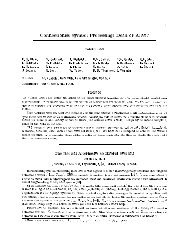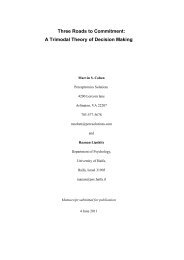Three Roads to Commitment: A Trimodal Theory of Decision Making
Three Roads to Commitment: A Trimodal Theory of Decision Making
Three Roads to Commitment: A Trimodal Theory of Decision Making
You also want an ePaper? Increase the reach of your titles
YUMPU automatically turns print PDFs into web optimized ePapers that Google loves.
<strong>Three</strong> <strong>Roads</strong> <strong>to</strong> <strong>Commitment</strong>: A <strong>Trimodal</strong> <strong>Theory</strong> <strong>of</strong> <strong>Decision</strong> <strong>Making</strong> 3<br />
decisions should be <strong>of</strong> paramount concern <strong>to</strong> cognitive engineers. <strong>Decision</strong> support or training may disrupt rather<br />
than improve decision making unless it is based on an apt understanding <strong>of</strong> decision making itself.<br />
Overview<br />
This paper introduces a theoretical framework, <strong>Trimodal</strong> <strong>Decision</strong> <strong>Making</strong>, or TDM. The discussion proceeds in<br />
five steps. In the next section, “<strong>Decision</strong> <strong>Making</strong> as Change in <strong>Commitment</strong>,” we develop a more inclusive<br />
conception <strong>of</strong> decisions, discuss an empirically testable approach <strong>to</strong> intentions, and describe some dimensions along<br />
which they vary. In the section, “<strong>Three</strong> Modes <strong>of</strong> <strong>Decision</strong> <strong>Making</strong>,” we argue that three distinct paths <strong>to</strong> change in<br />
commitment can be usefully distinguished – by starting points, questions that guide attention, deeply divergent<br />
justifications that they construct for actions, and different functionalities and priorities. In “<strong>Decision</strong> Strategies as<br />
Paths through the Framework,” we use diagrams and examples <strong>to</strong> show how TDM relates <strong>to</strong>, and accommodates<br />
insights from, other decision research paradigms, including both rational choice theory (the standard s<strong>to</strong>ry) and<br />
naturalistic alternatives proposed by Klein (1993), Beach, (1990), Connolly & Wagner (1988), Orasanu & Fischer<br />
(1997), Penning<strong>to</strong>n & Hastie (1993), and Montgomery (1993). The next section defines subjective and objective<br />
senses <strong>of</strong> “Action Uncertainty” in terms <strong>of</strong> questions, answers, and methods for answering questions that move<br />
decision makers <strong>to</strong>ward actionable commitment with varying degrees <strong>of</strong> efficiency; it also provides a decision<br />
modes x methods taxonomy <strong>of</strong> decisions and existing decision research paradigms. In the Conclusion, we briefly<br />
sketch high-level prescriptive implications for aiding and training. One <strong>of</strong> the most important tasks <strong>of</strong> cognitive<br />
engineering is <strong>to</strong> identify the different sources <strong>of</strong> rationality associated with commitments in particular domains, <strong>to</strong><br />
identify the most critical obstacles <strong>to</strong> those commitments, and develop ways <strong>of</strong> overcoming them.<br />
We do not claim that TDM is the only way <strong>to</strong> carve up the domain <strong>of</strong> decision making, or that it says everything<br />
there is <strong>to</strong> say about it. Our goal is nevertheless ambitious: <strong>to</strong> propose a substantive and insightful (or at least<br />
thought-provoking) theoretical framework for use in decision making research and prescription in real-world<br />
environments. Theories should be judged by efficiency (i.e., how much they explain relative <strong>to</strong> how much they<br />
assume), and fruitfulness ( e.g., novel empirical predictions and practical applications). With regard <strong>to</strong> efficiency,<br />
TDM will hopefully be recommended by a distinctive combination <strong>of</strong> empirical coverage and simplicity. A small<br />
number <strong>of</strong> concepts centering around an empirically grounded notion <strong>of</strong> commitment is sufficient <strong>to</strong> generate a<br />
richer and more inclusive view <strong>of</strong> decision making than <strong>of</strong>fered by the standard s<strong>to</strong>ry, <strong>to</strong> distinguish three decision<br />
making modes along normative and descriptive lines, delineate different types <strong>of</strong> action uncertainty, accommodate<br />
the findings <strong>of</strong> important existing decision research paradigms, and point <strong>to</strong> future directions in descriptive research




